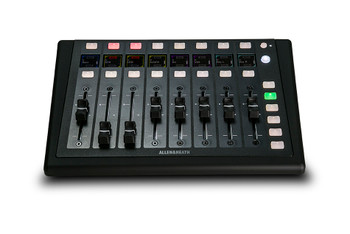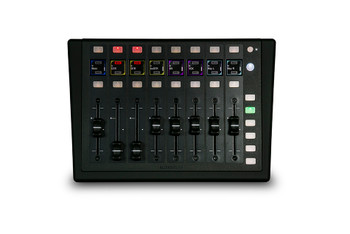Description
dLive DM64
The MixRack is the heart of any dLive system. It houses the XCVI processing core complete with audio I/O, control and audio networking ports. It is typically connected to a dLive Surface, but can also be controlled at the same time as or even without a Surface using a laptop or iPad, Allen & Heath IP remotes or third party controllers via TCP/IP.
There are 3 sizes of dLive MixRack available. All feature the same mix engine and differ only in the number of analogue I/O. All models can work with the full 128 channels by adding DX expanders or patching digital sources.
Features
- 64 mic/line inputs, 32 line outputs
- XCVI 160×64 FPGA core
- 96kHz sample rate
- Variable bit-depth for ultimate precision and noise performance
- Virtually infinite mix headroom thanks to 96bit accumulator
- Class leading, ultra-low latency < 0.7ms
- 128 Input Channels with full processing
- 64 Mix Outputs with full processing
- Configurable 64 bus architecture (group, FX, aux, matrix, mains)
- LR, LCR and up to 5.1 mains mode
- Multiple PFLs
- 16 RackExtra FX with dedicated stereo returns
- 24 DCAs
- AMM (Automatic Mic Mixer) up to 64 channels across 1, 2 or 4 zones
- Built-in signal generator and RTA
- New preamp design for extra transparency
- Unique Active PAD circuit for consistent performance with any source
- Connection hub
- Dual redundant GigaACE gigabit link to Surface
- 2x redundant DX links for I/O expansion
- 3x I/O Ports – 128 ch 96 kHz each
- Dedicated ME-1 48kHz port
- 2x Network ports
- Wordclock BNC I/O
- Add up to 46 DX I/O expanders via DX Hub modules or DX Link cards
- Dual redundant, hot swappable power supply
- Flush front panel with ultra quiet fan
- Reversible rack ears design
- 3 Year Warranty
XCVI Core
The power of dLive emanates from the XCVI Core – pioneered by the Allen & Heath R&D team using next generation FPGA technology, with 36 parallel virtual processing cores generating enough power for 160×64 channels of processing at 96kHz sampling rate. Six parallel mixing engines within the Core calculate over 10,000 cross points per sample, while the FPGA router has capacity for 3,000 x 3,000 audio paths. The massive power of XCVI (25 billion operations per second) allows dLive to deliver 128 full processing inputs and 16 stereo FX returns, a configurable 64 bus architecture, variable bit depth for ultimate precision and noise performance, a virtually infinite mix headroom thanks to a 96bit accumulator, and class leading latency at an ultra-low 0.7ms.
DEEP Processing
Our DEEP processing architecture embeds class-leading compressors and processing emulations directly within dLive’s input and mix channels. An array of bespoke algorithms including Graphic EQs, Compressors and a 64 channel Automatic Mic Mixer (AMM) can be inserted on the fly without burning FX slots and without the setup, latency and licence hassles associated with external plug-ins – they’re right there, where you need them, whenever you need them. The compressor models capture the audio nuances and non-linear ballistics of industry classics, ranging from a Slow-Opto model, various RMS detection and soft knee circuits, through to super-fast peak and RMS based compression/limiting devices.
RackExtra FX
The RackExtra FX portfolio combines the pristine quality and wide choice offered by boutique plug-ins with the convenience and low latency of onboard processing. It’s no secret that we have a passion bordering on obsession for crafting painstakingly faithful emulations of the most revered analogue outboard equipment. Drawing on the power of the XCVI Core, we have built hugely potent DSP kernels within the FPGA, allowing us to integrate our proven library of reverb, delay and modulator algorithms into dLive, with 16 FX slots available, each with a dedicated stereo return.
Automatic Mic Mixer (AMM)
AMM provides automatic level control of up to 64 microphones for spoken word applications such as conferences, panel shows, discussion forums and government / council meetings.
As well as reducing the risk of feedback, legibility is enhanced by minimising phase interference between channels, a common problem in multi-microphone spoken word applications.
Up to 4 zones can be enabled allowing automatic control of multiple rooms simultaneously from one interface.
Two modes of operation, NOM & D-Classic, are included:
- D-Classic utilises dynamic gain sharing and is quick and easy to set-up.
- NOM (Number of Open Microphones) builds on the logic based automatic mixing algorithm of our iDR install range offering additional parameters and maximum flexibility to the operator.
Built To Endure
Maybe it’s no coincidence that our lead mechanical designer on the dLive project used to be a tank commander. All dLive consoles have been designed to deliver the optimal balance between strength and weight, employing higher grade metal on the sides and folded steel at key points for added rigidity. Not only does every console, MixRack and expander have dual power supply slots for redundancy, but we’ve also employed the same rugged, hot-swappable PSU design across the range for maximum peace of mind and minimum inventory. Dual redundancy is also built into every audio connection throughout the system. We have also paid particular attention to console illumination, conducting rigorous trials to ensure that dLive excels in the sunny, outdoor settings where many digital consoles become almost unusable.
Specifications
Inputs
- Mic/Line XLR Inputs Balanced XLR, +48V phantom power
- Mic/Line Preamp Fully recallable
- Input Sensitivity -60 to +15dBu
- Analogue Gain +5 to +60dB, 1dB steps
- Pad -20dB Active PAD
- Maximum Input Level +30dBu (PAD in)
- Input Impedance >4kΩ (Pad out), >10kΩ (Pad in)
- Mic EIN -127dB with 150Ω source
- Phantom Power indication Per socket, internal or external phantom power sensing, triggered at 24V
Outputs
- Analogue XLR Outputs Balanced, Relay protected
- Output Impedance <75Ω
- Nominal Output +4dBu = 0dB meter reading
- Maximum Output Level +22dBu
- Residual Output Noise
- -92dBu (muted, 20-20kHz)
- -90dBu (muted, 20-40kHz)
System
Measured balanced XLR in to XLR out, 20-20kHz, minimum Gain, Pad out, signal @ 0dB (meter)
- Dynamic Range 110dB
- System Signal to Noise -92dB
- Frequency Response 20Hz - 30kHz +0/-0.8dB
- THD+N (analogue in to out) 0.0015% @ +16dBu output, 1kHz 0dB gain
- Headroom +18dB
- Internal operating Level 0dBu
- dBFS Alignment +18dBu = 0dBFS (+22dBu at XLR output)
- Meter Calibration 0dB meter = -18dBFS (+4dBu at XLR out)
- Meter Peak indication -3dBFS (+19dBu at XLR out)
- Sampling Rate 96kHz +/- 20 PPM
- ADC 24-bit Delta-Sigma
- DAC 24-bit Delta-Sigma
- Latency
- 0.7 ms (MixRack XLR in to XLR out, Input to Mix
- + 5 samples, Surface to Mixrack (GigaACE hop)
- + 8 samples, DX32 to Mixrack (DX hop)
Power
- Mains Voltage Operating Range 100-240V AC, 50/60H
- Mains Power Consumption
- 300W max (MPS16 V1 300W)
- 250W max (MPS16 V2 250W)
Temperature
- Operating Temperature Range
- Fitted with MPS16 V1 300w 0°C to 35°C (32°F to 95°F)
- Fitted with MPS16 V2 250w 0°C to 40°C (32°F to 104°F)
Dimensions and Weights
Width x Depth x Height x Weight
- DM64
- 482.6 x 313 x 458 mm (19"x 12.3"x 18") x 21kg (46lbs)
- DM64 - boxed
- 590 x 420 x 585 mm (23.2"x 16.5"x 23") x 24kg (52.9lbs)




















